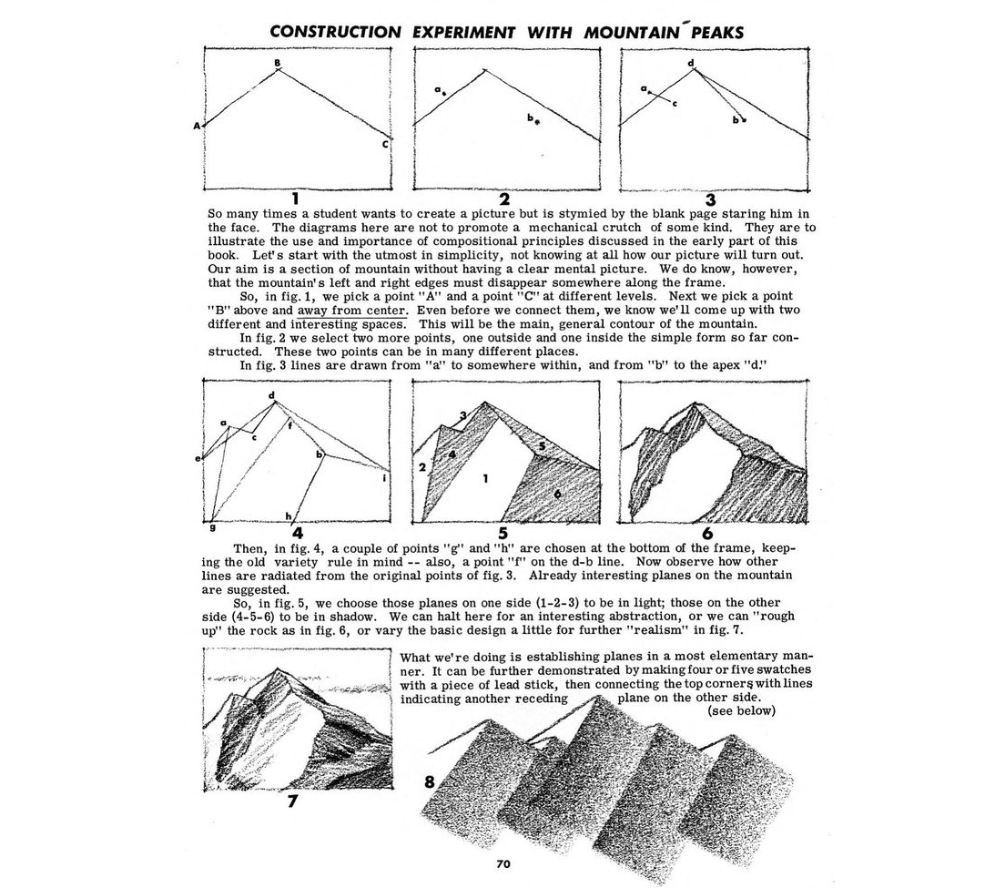Mountain Construction: A Dynamic Approach to Composition

This guide presents an experimental method for drawing mountain landscapes by focusing on abstract shapes, planes, and light/shadow interplay—perfect for overcoming the intimidation of a blank page. Below is a structured breakdown of the process, emphasizing creativity and foundational art principles.
Key Concepts
-
Start Simple: Begin with basic points and lines to define the mountain’s silhouette.
-
Embrace Uncertainty: Let the composition evolve organically without a fixed plan.
-
Variety & Contrast: Use asymmetry, overlapping planes, and light/shadow to create visual interest.
Step-by-Step Construction
Step 1: Establish the Framework (Fig. 1)
-
Points “A” and “C”: Place at different heights near the frame’s edges to imply slope.
-
Point “B”: Position above and off-center to break symmetry.
-
Connect the Dots: Form a jagged contour—this becomes the mountain’s general shape.
Step 2: Add Complexity (Fig. 2–4)
-
New Points: Introduce points inside and outside the initial shape (e.g., “a,” “b,” “d”).
-
Radiating Lines:
-
Draw from “a” to an interior point.
-
Connect “b” to the apex (“d”) to suggest ridges.
-
-
Base Points: Add “g” and “h” at the bottom for depth, and “f” along existing lines.
Step 3: Define Planes (Fig. 5)
-
Light vs. Shadow:
-
Light Side: Planes 1-2-3 (clean, minimal lines).
-
Shadow Side: Planes 4-5-6 (darker, textured).
-
-
Abstraction Option: Stop here for a geometric, stylized look.
Step 4: Refine for Realism (Fig. 6–7)
-
Texture: “Rough up” edges with uneven lines for rocky surfaces.
-
Depth: Add smaller planes or cracks within shadowed areas.
Pro Tips
-
Lead Stick Technique: Smudge soft graphite to create tonal swatches, then carve out planes with erasers.
-
Dynamic Lines: Use varied pressure—sharp lines for ridges, blurred strokes for distant slopes.
-
Rule of Variety: Avoid repetition in angles and spacing to mimic nature’s irregularity.
Why This Works
-
Overcomes Blank-Page Fear: The point-based method removes pressure to “get it right” immediately.
-
Teaches Composition: Highlights how abstract shapes underpin realistic landscapes.
-
Adaptable Style: Works for everything from minimalist art to detailed illustrations.
Try It Out: Start with three random dots and see where they take you! Need a visual demo or feedback on your mountain sketch? Let me know! 🏔️✏️
